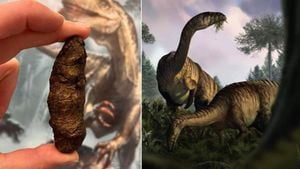Recent research conducted by Curtin University has shattered long-held beliefs about the origin of Stonehenge’s Altar Stone, claiming it actually hails from Scotland instead of Wales as previously thought. This significant finding suggests ancient peoples possessed sophisticated transport methods and societal structures as early as 2600 BC.
The Altar Stone, which is prominently displayed at the center of Stonehenge, weighs approximately six tons and measures five meters long. Scientists embarked on this investigative project by analyzing mineral fragments which revealed they are distinctively compatible with geological features found only in Scotland.
Anthony Clarke, the lead author and PhD student at Curtin, noted their findings show the age and chemical composition of the Altar Stone's minerals align closely with rocks from the northeast of Scotland, distinctly separating them from Welsh bedrock. The minerals identified range between 450 million years old and 2000 million years old, offering not just geological insight but also historical context about the stone's transportation method.
According to Clarke, “The distinct chemical fingerprint indicates the stone's origins from the Orcadian Basin, located at least 750 kilometers from Stonehenge.” He expressed the amazing complexity and coordination needed by Neolithic communities to transport such massive resources over great distances, all the way to the English countryside.
The study involved collaboration with several prestigious universities, including Aberystwyth University and University College London. This multi-institutional effort emphasizes the significance of community cooperation across regions during the Neolithic era.
Professor Chris Kirkland, another study co-author, pointed out the social structures involved, stating, “Transporting such massive cargo suggests long-distance trade networks and a level of societal coordination often overlooked.” The existence of these trade routes reveals more than just transportation; it highlights the connections and relationships forged between communities across Britain.
Kirkland emphasized the challenges posed by such undertakings, with forests and varied terrains likely complicate logistics. “A likely marine shipping route along the coast or substantial overland pathways would have been necessary,” he explained.
These findings stand contrary to beliefs held since the 1920s, when the stone was typically associated with old red sandstone from the Welsh regions. For decades, the Altar Stone was thought to be sourced from Western Wales, and this new data has now prompted questions about the lore and legends surrounding the monument.
The purposes and meanings encapsulated within Stonehenge continue to intrigue and baffle historians and archaeologists alike. While some believe it was burial ground or ceremonial monument, others note its alignment with celestial phenomena.
Recent studies support the idea of communal gatherings facilitated by the construction and movement of monolithic stones like the Altar Stone. This monumental endeavor suggests social, political, and cultural unity among disparate groups across ancient Britain.
Another significant aspect emerging from this discovery is how the stone may connect to wider archaeological findings. For example, previous research indicates communities may have transported cattle and pottery across long distances, hinting at exchanges of ideas and engineering capabilities.
Professor Richard Bevins from Aberystwyth University lauded the research, commenting, “It’s remarkable how we can assess the origins of such emblematic stones like the iconic Altar Stone of Stonehenge.” While they have confirmed its Scottish roots, the exact location within Scotland remains under investigation, akin to finding the needle within the haystack.
Dr. Robert Ixer of UCL echoed this sentiment, stating, “The work prompts two important questions: how and why was the Altar Stone moved such vast distances?” These inquiries underscore the navigational and environmental challenges faced threshold communities thousands of years ago.
The research is rooted deeply within modern technological advances, equipping researchers with tools previously unavailable. Instruments like state-of-the-art mass spectrometers and handheld X-ray fluorescence were integral to this groundbreaking study.
Clarke remarked on the importance of these modern techniques, “Curtin University has enabled us to explore fascinating work using the most advanced scientific equipment available.” His experiences at the university highlight the global collaboration and innovative spirit propelling the research.
Research funding from the Australian Research Council underscores the importance of investment in scientific inquiries such as this. It highlights the need to sustain advanced research facilities capable of handling specialized studies, paving the way for similar investigations globally.
With the Altar Stone’s reconstructive mystery partly unraveled, archaeologists insist the revelations help rewrite parts of the historical narrative concerning prehistoric Britain. The stone’s long migration paints ancient communities not as isolated but as interconnected, collaborative societies.
This intriguing theoretical framework leaves more questions than answers, compelling continued exploration of how communities interacted with each other over land and sea. The ways this social interaction manifested will unfurl with future discoveries.
Claudius von Briel, co-author of this study, articulated the excitement deriving from their investigation, “Our findings are not just about one stone but rather what it represents about communities, cooperation, and trade routes.” The history of the Altar Stone gives us insight not only about itself but also about the people who moved it.
This comprehensive study emphasizes how the early British people were not merely competent builders but sophisticated traders contributing to economic and social networks spanning the British Isles. The community dynamics built around Stonehenge will certainly invoke ideas about unity and shared identity.
Professor Harlene Hayne, vice-chancellor of Curtin University, described this study as another achievement for the Timescales of Mineral Systems Group. Through this lens, one can appreciate just how research projects like these tap the potential of interdisciplinary collaboration, marrying techniques from geology, archaeology, and history.
With the Altar Stone's origins confirmed, its story now integrates seamlessly within the larger narrative of prehistoric Britain’s history. It serves as a bridge connecting various regions and discussions about people’s ambitions, creativity, and their striving for communal identity by embracing what they could share.
Thus, Stonehenge ceases to be merely about ancient stones; it morphs instead to encompass the fabric of relationships and cooperation stitched together by these timeless rocks standing witness to our past.
With every new research endeavor aimed at unlocking more mysteries of prehistoric Britain, expectations and excitement grow for what potential new finds await. The story of the Altar Stone is far from over; rather, it is just beginning to be conceptualized anew.
The research surrounding the Altar Stone not only reshapes our historical appreciation of this landmark but also gets us thinking about ancient peoples and their interconnected lives.
This unique narrative grants us insight, reminding us of the human connections and collective ambitions behind such monumental structures. The Altar Stone now stands not just as stone but as symbolic proof of unity and communal purpose thriving throughout ancient Britain.



